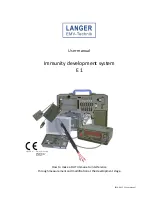indicates that a write to PUSHR is complete. Writing a '1' to the TFFF bit also clears it.
The TFFF can generate a DMA request or an interrupt request. See
for details.
The module ignores attempts to push data to a full TX FIFO, and the state of the TX
FIFO does not change and no error condition is indicated.
44.4.2.4.2 Draining the TX FIFO
The TX FIFO entries are removed (drained) by shifting SPI data out through the shift
register. Entries are transferred from the TX FIFO to the shift register and shifted out as
long as there are valid entries in the TX FIFO. Every time an entry is transferred from the
TX FIFO to the shift register, the TX FIFO Counter decrements by one. At the end of a
transfer, the TCF bit in the SR is set to indicate the completion of a transfer. The TX
FIFO is flushed by writing a '1' to the CLR_TXF bit in MCR.
If an external bus master initiates a transfer with a module slave while the slave's TX
FIFO is empty, the Transmit FIFO Underflow Flag (TFUF) in the slave's SR is set. See
Transmit FIFO Underflow Interrupt Request
for details.
44.4.2.5 Receive First In First Out (RX FIFO) buffering mechanism
The RX FIFO functions as a buffer for data received on the SIN pin. The RX FIFO holds
4 received SPI data frames. The number of entries in the RX FIFO is device-specific. SPI
data is added to the RX FIFO at the completion of a transfer when the received data in the
shift register is transferred into the RX FIFO. SPI data are removed (popped) from the
RX FIFO by reading the module POP RX FIFO Register (POPR). RX FIFO entries can
only be removed from the RX FIFO by reading the POPR or by flushing the RX FIFO.
The RX FIFO Counter field (RXCTR) in the module's Status Register (SR) indicates the
number of valid entries in the RX FIFO. The RXCTR is updated every time the POPR is
read or SPI data is copied from the shift register to the RX FIFO.
The POPNXTPTR field in the SR points to the RX FIFO entry that is returned when the
POPR is read. The POPNXTPTR contains the positive offset from RXFR0 in a number
of 32-bit registers. For example, POPNXTPTR equal to two means that the RXFR2
contains the received SPI data that will be returned when the POPR is read. The
POPNXTPTR field is incremented every time the POPR is read. The maximum value of
the field is equal to the maximum implemented RXFR number and it rolls over after
reaching the maximum.
Chapter 44 Serial Peripheral Interface (SPI)
K22F Sub-Family Reference Manual , Rev. 3, 7/2014
Freescale Semiconductor, Inc.
1073

















